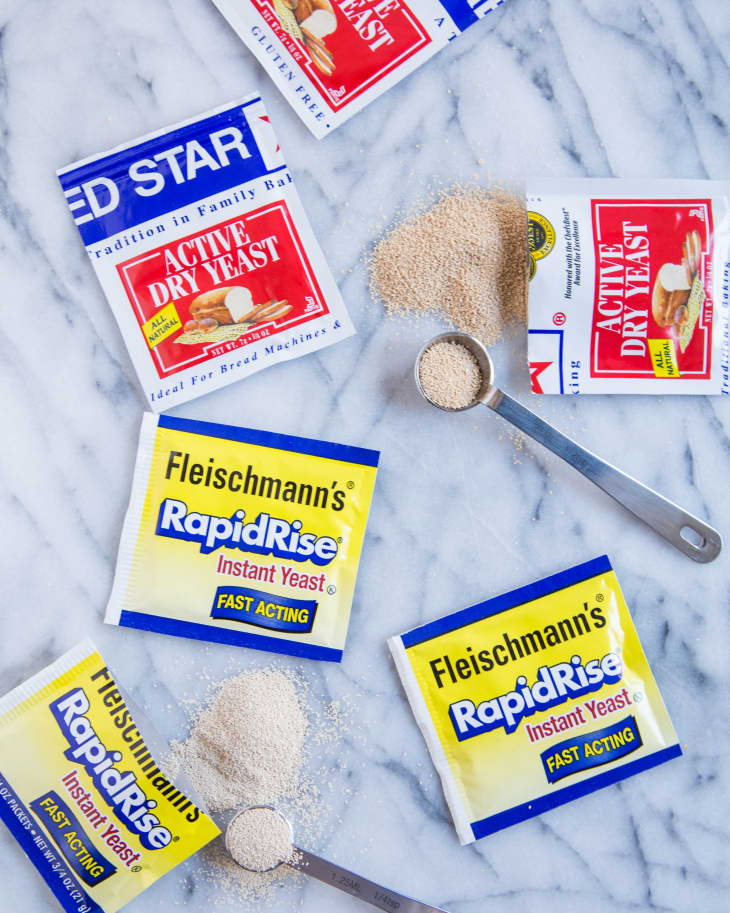What’s the Difference Between “Active Dry” Yeast and “Instant” Yeast?
If you enjoy making bread at home, especially when they come out of the oven perfectly risen, then you know how important working with yeast is. I’ve been baking and buying yeast for years, and the yeast choices in the baking aisle still get me confused. Here’s the thing, though: There is a difference between active dry yeast and instant yeast, and which one you use does make a difference in your recipe.
Active dry yeast and instant yeast both help leaven bread and provide an airy, light texture, but they do so in slightly different ways and there’s one major difference in how you use them: Active dry yeast needs to be dissolved in water before using, while instant yeast can be mixed right into dry ingredients.
The Difference Between Active Dry Yeast and Instant Yeast
Active dry yeast and instant yeast are both used to help bread rise as it bakes in the oven, creating a fluffy interior. The main difference between active dry yeast and instant yeast, however, is that active dry yeast must be dissolved or “activated” in water before it is then incorporated into the dry ingredients used to make bread. Instant yeast, though, can be incorporated directly into the mixture.
What Is Active Dry Yeast?
This is probably what comes to mind when you think of yeast — and it’s the most common variety sold in grocery stores. It’s a type of dry yeast that’s granular, with a consistency similar to cornmeal. It’s a living organism that’s dormant until proofed, or dissolved in a small amount of lukewarm warm water (about 110°F). It’s then added to the rest of the ingredients, where it causes dough to rise.
Active dry yeast is typically sold in individual packets (pictured above) or small glass jars. If using the latter, just make sure to refrigerate it after opening so the yeast stays fresh and active.
What Is Instant Yeast?
Instant yeast is another type of dry yeast that was introduced after active dry yeast in the 1970s. It is made using a similar process as active dry yeast, although it is dried more quickly and milled into finer particles. Because of this, it dissolves and activates faster. Unlike active dry yeast, instant yeast doesn’t have to be proofed first; it can be mixed straight into the dry ingredients with the same result. This yeast also gives you two separate rises.
What Is Rapid-Rise or Quick-Rise Yeast?
Instant yeast may also be marketed and sold as rapid- or quick-rise yeast. This yeast has also been milled into smaller particles so it doesn’t need to be dissolved into water. In addition, enzymes and other additives are included to make the dough rise faster. With this yeast, you can skip the first rise of the dough and shape the loaves right after kneading. Like the name implies, this type of yeast is great for quick baking projects and cuts out the added time it takes for multiple rises.
Which Type of Yeast Should I Use?
This part is really up to you. While each type of yeast reacts differently and produces baked goods with slight variations, there’s no one right answer. I recommend picking one kind of yeast, becoming familiar with it, and using it in everything — unless the recipe gives a specific reason to do otherwise. The good news is that as long as you have some variety of yeast on hand, you can make any recipe calling for yeast and the specific type it calls for doesn’t really matter.
How Do You Substitute Instant Yeast for Active Dry Yeast?
Active dry yeast and instant yeast can generally be used interchangeably, one-for-one (although active dry yeast may be slower to rise). So if a recipe calls for instant yeast and you use active dry yeast instead, you may want to consider adding an extra 10 to 15 minutes for the rise time. If a recipe calls for active dry and instant is used, reduce the rise time by 10 to 15 minutes. Other than that the recipe can stay exactly the same and there is no need to make any changes.
